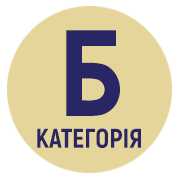DEVELOPMENT OF MOTOR SKILLS IN CHILDREN WITH CEREBRAL PALSY WITH THE HELP OF EXERCISE THERAPY USING MUSICAL AND RHYTHMIC ACCOMPANIMENT
DOI:
https://doi.org/10.32782/3041-1351/2024-2-2Keywords:
children’s cerebral palsy, therapeutic physical culture, mobile games, music and rhythmAbstract
Introduction. Movement disorders in children with cerebral palsy are caused by dysfunction of the brain parts, which leads to impaired muscle tone, which in turn affects the performance of voluntary movements. Physical exercises and active games are effective methods that normalize muscle tone, stimulate limbs movements, which, according to the laws of feedback, stimulates the development of the brain motor centers. Active games with musical and rhythmic accompaniment ensure the development of general and fine motor skills of the hands, the child's stability in an upright position, and the correction of incorrect posture. Game activities are aimed at relaxing spastic muscles and stimulating atonic muscles. Purpose and objectives are to correct motor functions in older preschool children using active games with musical and rhythmic accompaniment. Results. A diagnostic study of general and fine motor skills in older children with different forms of cerebral palsy showed that the level of development of these indicators is below average. In physical therapy classes, we used mobile games to develop general and fine motor skills, games to develop attention and reaction speed, games to develop eye-hand coordination, and exercises to develop psychomotor abilities. The use of music increases the efficiency of task performance, relieves muscle tension, stimulates and coordinates movements. We have given special importance to musical and rhythmic accompaniment in active games, especially music by Ukrainian authors and Ukrainian folk songs. The results of repeated diagnostics showed that the development of fine motor skills in 37.5% and general motor skills in 25% of children correspond to a high level of development. The findings data obtained show the effectiveness of mobile games in correcting motor skills in children with cerebral palsy. This is manifested in an increase in volume, the appearance of smoothness and accuracy, improved coordination and speed of movements.
References
Долбенко С. В. Використання нетрадиційних засобів діяльності для розвитку дрібної моторики дітей дошкільного віку. Дошкільний навчальний заклад. 2018. № 4. С. 6–12.
Грубар І., Грабик Н., Гулька О. Соціальна адаптація дітей з ДЦП засобами фізичного виховання. ІІ Всеукраїнська міждисциплінарна науково-практична конференція «Інклюзивна освіта: ідея, стратегія, результат»: матеріали конференції. Тернопіль, 2022. с. 55–59. URL: http://dspace.tnpu.edu.ua/handle/123456789/25819
Кашуба В., Чухловіна В. Технологія корекції рухових порушень у дітей молодшого шкільного віку зі спастичними формами церебрального паралічу. Спортивний вісник Придніпров’я. 2017. № 2. С. 177–182.
Парасюк І. Ф. Визначення рівня розвитку дрібної моторики у дітей старшого дошкільного віку із ЗНМ. Актуальні питання спеціальної інклюзивної і здоров’язбережувальної освіти: зб. наук. праць. Харків 2022. С. 134–137.
Співак Б. Г., Вітензон А. С. Клініко-біомеханічні передумови корекції ходи хворих на ДЦП за рахунок стимуляції м’язів. Протезування. 2016. С. 65–73.
Ружицька Л. І. Клінічна характеристика дитячого церебрального паралічу. Проблеми сучасної психології: зб. наук. праць. 2019. 15. С. 564–575. URL: http://heartandvessels.com.ua/index.php/2227-6246/ article/view/160716
Чеботарьова О.В. Дитина із церебральним паралічем. Харків : Вид-во «Ранок», ВГ «Кенгуру», 2018. 40 с.
Чемеріс М., Худецький І. Ю., Антонова-Рафі. Ю. В. Підходи та методи фізичної терапії дітей при церебральному паралічі зі спастичною диплегією. Клінічна та профілактична медицина. 2022. № 3. с. 55–61 URL: https://cp-medical.com ›




